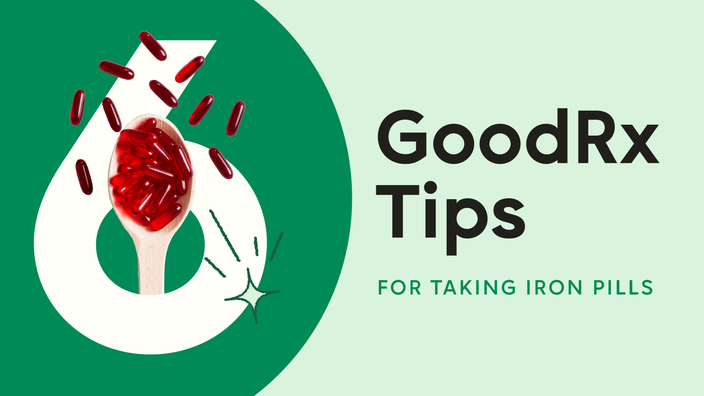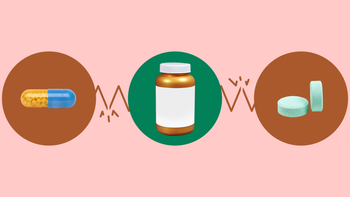
What Pharmacists Say About How Long Iron Pills Take to Work (Plus 5 More Tips)
Key takeaways:
Iron pills (iron supplements) prevent and treat low iron levels in kids and adults. Ferrous fumarate, ferrous sulfate, and ferrous gluconate are the most common types of iron.
Oral iron supplements usually start working in about 3 to 7 days. Symptoms of iron deficiency should start to improve after 2 to 4 weeks of supplementation, but your hemoglobin levels could take up to 2 months to return to normal.
Common side effects of iron supplements include constipation, nausea, and stomach pain. Taking your iron doses with food can help prevent an upset stomach.
Access savings on related medications

Iron is a mineral our bodies need to stay healthy. We need it to make hemoglobin, an important protein found in red blood cells. Hemoglobin helps these disc-like cells deliver oxygen throughout your body. Without iron, or if you’re not getting enough iron, it’s possible to develop symptoms of anemia.
For the most part, people in the U.S. get enough iron from their diets. Iron is found in foods like meat, certain beans and nuts, and seafood. It’s also found in iron-fortified breakfast cereals and breads. Eating foods that contain iron is the ideal way to keep your iron levels steady.
But, depending on your circumstances, you may not get enough iron from your diet. Or you may have low iron levels from a health condition. In these cases, iron supplements are a handy way to bump up your iron levels. If your healthcare provider does recommend an iron supplement, you may have some questions about how to take it, signs iron pills are working, and how long it takes to get iron levels up.
What are iron pills?
While browsing the aisles of your local pharmacy or supermarket, you’ve likely come across iron pills. They prevent and treat low iron levels in kids and adults. Many of them are available as over-the-counter (OTC) stand-alone products. But you can also find iron in many multivitamins and prescription medications.
Iron has important benefits, too. The mineral helps your red blood cells transport oxygen throughout your body. This fuels your muscles, internal organs, and more. Iron is a key player in your growth and development. But you shouldn’t take iron pills unless directed by your healthcare provider. People with normal iron levels don’t get more benefits from taking extra iron.
Types of iron pills
Oral iron supplements are available as capsules, tablets, and liquids. Each formulation contains a specific type of elemental iron — the form of iron your body actually absorbs.
Read more like this
Explore these related articles, suggested for readers like you.
The most common forms of iron are ferrous sulfate, ferrous fumarate, and ferrous gluconate. Ferrous fumarate contains the most amount of iron, and ferrous gluconate contains the least.
Iron type | Elemental iron percentage |
Ferrous fumarate | 33% |
Ferrous sulfate | 20% |
Ferrous gluconate | 12% |
Before you make any purchases, make sure to check out the “Supplement Facts” label. This describes the amount of elemental iron contained in the supplement, which helps ensure you take the right dose. Your healthcare provider or pharmacist can advise you on the best form and dosage of iron to take.
6 pharmacist-backed tips for taking iron pills correctly
It’s natural to have questions about iron pills before you start taking them. You may be wondering how long they take to work. Or if there are any tips to help you if you experience side effects while taking iron. Your pharmacist and healthcare provider can help answer these questions and more.
1. How long does it take iron to work?
Iron pills typically start to work within 3 to 7 days. However, it can take some time to actually get your iron levels up. Hemoglobin blood levels generally go up after 2 to 4 weeks of consistent supplementation. Symptoms like fatigue, weakness, and headache should start to improve during this timeframe. But it can take up to 2 months for symptoms to go fully away and for your hemoglobin levels to return to normal.
Your healthcare provider will likely check your iron levels routinely to make sure they’re getting better. They may also recommend continuing to take iron supplements for at least 6 months after your iron levels return to normal. This is to make sure the iron in your body is fully replenished. Your healthcare provider can tell you how long you should take iron for.
2. When is the best time to take iron supplements?
In general, the best time to take iron pills is in the morning before eating. This helps maximize its absorption. But you may need to take iron pills more than once daily. If so, you can also take it at night.
Reach out to your pharmacist or healthcare provider with any questions about the best time to take iron supplements. In some cases, they may recommend taking it every other morning instead of every morning.
Good to know: You may need to separate iron from certain medications and foods. More on this in just a bit.
3. Should I take iron with food?
Your body absorbs iron best on an empty stomach — when your stomach is more acidic. It's best to take iron without food when possible.
However, iron supplements may upset your stomach. If this happens, you can take them with a snack or small meal. But to keep your stomach more acidic, ask your healthcare provider about taking iron with a vitamin C supplement or a glass of orange juice. These types of products should help your body absorb iron better when taken with food.
Food aside, make sure to take your iron supplement with plenty of water. Iron supplements can cause constipation, but water can help prevent this from happening.
4. Should I separate iron from any medications or foods?
Yes, iron interacts with certain medications and foods. Separating them throughout the day can help prevent certain interactions.
Iron supplements may cause certain medications to not work as well:
Tetracycline antibiotics: Iron can bind to antibiotics like doxycycline in your gut, making them less effective. It’s best to separate doxycycline and iron supplements by about 2 to 3 hours.
Levothyroxine (Synthroid): Taking levothyroxine and iron at the same time can make levothyroxine less effective. You should separate these medications by at least 4 hours.
Levodopa (found in Sinemet): Iron supplements can decrease the amount of levodopa in the body, making it less effective. It’s best to avoid taking levodopa and iron at the same time. Your pharmacist can tell you how far to space these apart.
Ciprofloxacin (Cipro): Iron supplements can lower your body’s absorption of this antibiotic. It’s best to take ciprofloxacin at least 2 hours before or 6 hours after taking iron supplements.
Drug interactions are a two-way street. Some medications and foods can also make iron supplements less effective.
For instance, proton pump inhibitors like omeprazole (Prilosec) lower the amount of acid in your stomach. This can lessen how much iron your body absorbs into its bloodstream. Supplements and foods that contain calcium — like milk, yogurt, or ice cream — can also interfere with iron absorption. It’s best to separate calcium and iron products by at least 2 hours.
What’s more, beverages that contain caffeine may lower iron’s absorption and make it less effective. It’s best to enjoy your cup of coffee or tea before or after your iron doses.
Other interactions are also possible. To help them screen for interactions, make sure your pharmacist and healthcare provider have an updated list of all prescription and OTC medications you take.
5. What happens if I miss my dose of my iron pill?
It can be hard to fit your medications into your daily routine. If you forget to take your iron pill, take it as soon as you remember. If it’s almost time for your next dose, skip the missed one and go back to your regular schedule. Never double up on your iron pills.
If you find yourself forgetting doses frequently, your pharmacist can provide helpful tips for remembering to take your medications. Setting reminders on your phone or calendar are two possible options. If you take several medications, pill organizers are also good tools. The GoodRx Medicine Cabinet feature can also help you manage your medications.
6. What can I do if I experience side effects from my iron pills?
Iron supplements are generally well-tolerated. But some side effects are still possible. Common iron side effects include:
Diarrhea
Nausea
Vomiting
Gas
Stomach pain
Teeth staining
There are ways to manage side effects like these. For instance, liquid iron supplements cause teeth staining more than tablets or capsules. You can mix liquid iron with water or fruit juice to help prevent this from happening. Drinking the medicine with a straw can also help. And if iron leaves an unpleasant taste in your mouth, chewing gum and drinking water shortly after your dose can make a difference.
You may also be alarmed to see that your stool color may turn black or green while taking iron supplements. This is completely normal and temporary. But contact your healthcare provider if you notice red streaks in your stool — this could be a sign of bleeding. You should also reach out to your healthcare provider if any side effects feel severe or don’t go away.
What are some signs that iron pills are working?
If your symptoms start improving, that’s a sign your iron pills are working.
While some people may not experience any symptoms at all with low iron levels, common ones include:
Feeling tired
Headaches
Dizziness
Trouble concentrating
Fast heartbeat
Brittle nails
Hair loss
Pale skin
If you don’t notice any major differences in how you feel, your healthcare provider can check your hemoglobin levels to see if you’re on the right track. Normal hemoglobin levels are at least 12 g/dL for women and 13.5 g/dL for men.
Tips on how to save money on your iron pills
Iron supplements are available as relatively affordable generic OTC medications. But there are many ways to save on your supplement, especially if you fill iron as a prescription. GoodRx can help you navigate your options, which may include GoodRx discounts. You can find iron supplements for as low as $6 with a free GoodRx discount.
The bottom line
If you have symptoms of anemia caused by low iron levels, you may start to feel better within a few weeks of starting an oral iron supplement. But it will likely take longer for your hemoglobin levels to go back to where they should be — possibly up to 2 months. The top signs that your iron pills are working are improvements in your symptoms and normalizing hemoglobin levels.
Like all medications, iron supplements also have some side effects and interactions to be aware of. Before you start taking an iron supplement, make sure your healthcare provider tells you it's OK to take.
Why trust our experts?



References
Alleyne, M., et al. (2008). Individualized treatment for iron-deficiency anemia in adults. The American Journal of Medicine.
American Society of Hematology. (n.d.). Anemia.
Braunstein, E. M., (2022). Iron deficiency anemia. Merck Manual Consumer Version.
Campbell, N. R. C., et al. (1991). Iron supplements: A common cause of drug interactions. Journal of Clinical Pharmacology.
Gerber, G. F. (2023). Iron deficiency anemia. Merck Manual Professional Version.
Lane, D. J., et al. (2016). Bonnie and Clyde: Vitamin C and iron are partners in crime in iron deficiency anaemia and its potential role in the elderly. Aging.
MedlinePlus. (2022). Iron supplements.
MedlinePlus. (2023). Taking iron supplements.
National Institutes of Health, Office of Dietary Supplements. (2023). Iron: Fact sheet for consumers.
National Institutes of Health, Office of Dietary Supplements. (2023). Iron: Fact sheet for health professionals.
Nguyen, M., et al. (2023). Iron supplementation. StatPearls.
RemedyRepack Inc. (2023). Doxycycline- doxycycline capsule [package insert].
Stoffel, N. U., et al. (2017). Iron absorption from oral iron supplements given on consecutive versus alternate days and as single morning doses versus twice-daily split dosing in iron-depleted women: Two open-label, randomised controlled trials. The Lancet: Haematology.
U.S. Food and Drug Administration. (2005). Dietary Supplement Labeling Guide: Chapter IV. Nutrition labeling.
von Siebenthal, H. K., et al. (2023). Effect of dietary factors and time of day on iron absorption from oral iron supplements in iron deficient women. American Journal of Hematology.
















